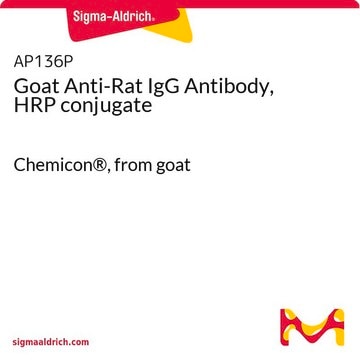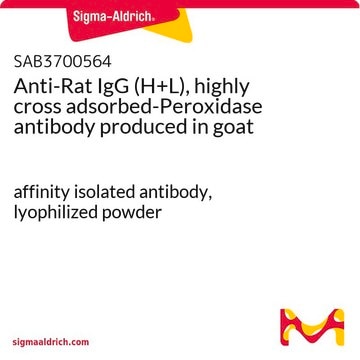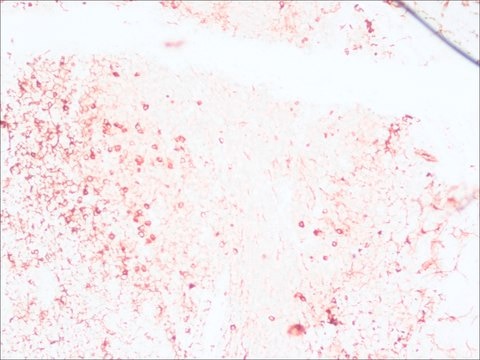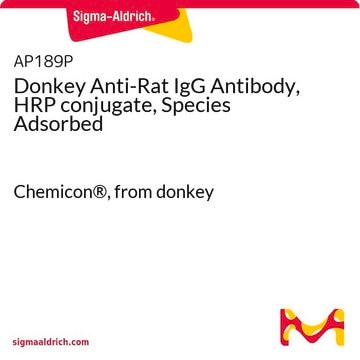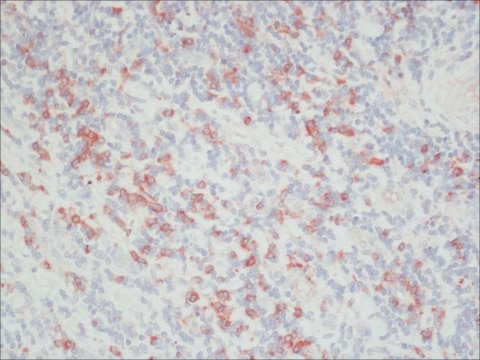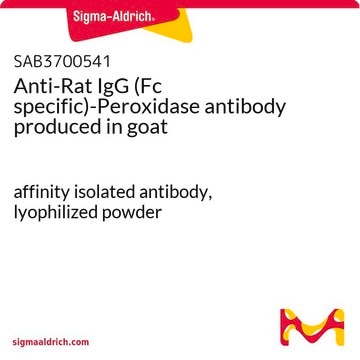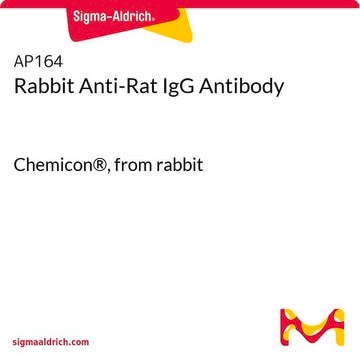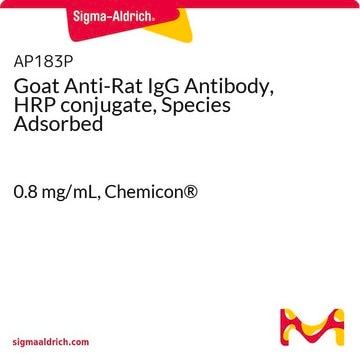AP202P
Goat Anti-Rat light chain Antibody, HRP conjugate
Chemicon®, from goat
Sign Into View Organizational & Contract Pricing
All Photos(1)
About This Item
UNSPSC Code:
12352203
eCl@ss:
32160702
NACRES:
NA.41
Recommended Products
biological source
goat
Quality Level
conjugate
peroxidase conjugate
antibody form
affinity purified immunoglobulin
antibody product type
secondary antibodies
clone
polyclonal
species reactivity
rat
manufacturer/tradename
Chemicon®
technique(s)
ELISA: suitable
immunocytochemistry: suitable
immunohistochemistry: suitable
western blot: suitable
isotype
IgG
shipped in
wet ice
target post-translational modification
unmodified
Related Categories
General description
Light chains covalently bound to a pair of heavy chains to form an antibody molecule. Immunoglobulin light chains occur in two types, kappa or lambda. Light chain′s mass is about 25,000 Daltons per mole. Each light chain consists of about 250 amino-acids long. These are usually designated by the Greek letters kappa and lambda. The ratio of kappa to lambda found in the immunoglobulin population varies by species.
Specificity
Minimal cross-reaction with bovine, goat, horse, mouse, human, rabbit, and sheep.
The antibody reacts strongly with native primary antibodies primarily with kappa light chains. It is not suitable for detecting lambda light chains. The antibody does not react with the heavy chain of rat IgG. The antibody has been tested by ELISA and adsorbed to ensure minimal cross-reaction with bovine, goat, horse, mouse, human, rabbit, and sheep immunoglobulins.
Immunogen
Epitope: Kappa light chain
Prepared from purified rat IgG light chain.
Application
Goat anti-Rat light chain Antibody, HRP conjugate is an antibody against light chain for use in ELISA, WB, IC, IH.
Research Category
Secondary & Control Antibodies
Secondary & Control Antibodies
Research Sub Category
Fragment Specific Secondary Antibodies
Fragment Specific Secondary Antibodies
Western Blotting: 1:5,000 -1:100,000 with chromogenic substrates
1:10,000 -1:200,000 with ECL substrates
ELISA: 1:5,000 -1:100,000
Immunohistochemistry: 1:500 - 1:5,000
Immunocytochemistry: 1:500 - 1:5,000
Optimal working dilutions must be determined by the end user.
1:10,000 -1:200,000 with ECL substrates
ELISA: 1:5,000 -1:100,000
Immunohistochemistry: 1:500 - 1:5,000
Immunocytochemistry: 1:500 - 1:5,000
Optimal working dilutions must be determined by the end user.
Target description
25 kDa
Physical form
ImmunoAffinity Purified
Purified by immunoaffinity chromatography. Lyophilized in 0.01M Sodium Phosphate, 0.25M NaCl, pH 7.6. 15 mg/mL BSA as stabilizer.
Storage and Stability
Maintain lyophilized product at 2°-8°C for up to 12 months. Reconstitute vial with of distilled water (addition of 0.5 ml water will yield a final concentration of 1 mg/mL). After reconstitution the product is stable for six weeks at 2°-8°C in the dark as an undiluted liquid. For extended storage after reconstitution, add an equal volume of glycerol to make a final concentration of 50% glycerol followed by storage at -20°C in undiluted aliquots for up to 12 months. Please note the concentration of protein (and buffer salts) will decrease to one-half of the original after the addition of glycerol. Avoid repeated freeze thaw cycles. Keep away from light.
Legal Information
CHEMICON is a registered trademark of Merck KGaA, Darmstadt, Germany
Disclaimer
Unless otherwise stated in our catalog or other company documentation accompanying the product(s), our products are intended for research use only and are not to be used for any other purpose, which includes but is not limited to, unauthorized commercial uses, in vitro diagnostic uses, ex vivo or in vivo therapeutic uses or any type of consumption or application to humans or animals.
Not finding the right product?
Try our Product Selector Tool.
wgk_germany
WGK 3
Certificates of Analysis (COA)
Search for Certificates of Analysis (COA) by entering the products Lot/Batch Number. Lot and Batch Numbers can be found on a product’s label following the words ‘Lot’ or ‘Batch’.
Already Own This Product?
Find documentation for the products that you have recently purchased in the Document Library.
Anna M Wirsing et al.
Tumour biology : the journal of the International Society for Oncodevelopmental Biology and Medicine, 37(2), 2449-2459 (2015-09-19)
Staging of oral squamous cell carcinoma is based on the tumour-node-metastasis (TNM) system, which has been deemed insufficient for prognostic purposes. Hence, better prognostic tools are needed to reflect the biological diversity of these cancers. Previously, high numbers of specialized
Characterisation and prognostic value of tertiary lymphoid structures in oral squamous cell carcinoma.
Wirsing, AM; Rikardsen, OG; Steigen, SE; Uhlin-Hansen, L; Hadler-Olsen, E
BMC Clinical Pathology null
Anna Maria Wirsing et al.
Modern pathology : an official journal of the United States and Canadian Academy of Pathology, Inc, 31(6), 910-922 (2018-02-09)
Oral squamous cell carcinomas are associated with a poor prognosis, which may be partly due to functional impairment of the immune response. Lymphocyte recruitment to the tumor site is facilitated by high-endothelial venules, whereas expression of programmed-death ligand 1 (PD-L1)
Stine L Figenschau et al.
BMC cancer, 15, 101-101 (2015-04-18)
Tertiary lymphoid structures (TLS) are highly organized immune cell aggregates that develop at sites of inflammation or infection in non-lymphoid organs. Despite the described role of inflammation in tumor progression, it is still unclear whether the process of lymphoid neogenesis
Our team of scientists has experience in all areas of research including Life Science, Material Science, Chemical Synthesis, Chromatography, Analytical and many others.
Contact Technical Service